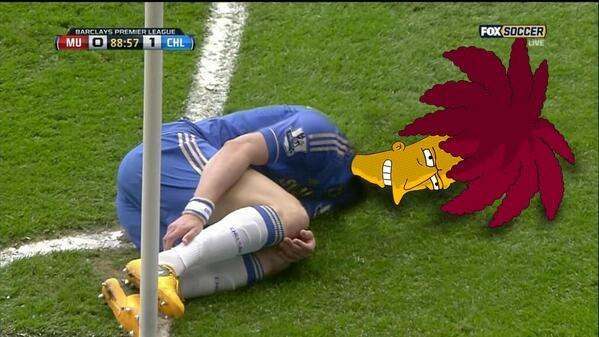Not if they hire Mourinho, which makes sense since he has been gunning for that for years.
In other news, this is digraceful shit (long but worth ze read):
Anfield: An area in decline
(from 'The Guardian' by David Conn)
In the blighted streets around Liverpool's Anfield stadium, residents are packing up and leaving their family homes, so the football club can have them demolished and expand their Main Stand. In the six months since the club scrapped their decade-long plan to build a new stadium on Stanley Park, and reverted to expanding Anfield instead, Liverpool city council has been seeking to buy these neighbours' homes, backed by the legal threat of compulsory purchase.
People's farewells are bitter, filled with anger and heartbreak at the area's dreadful decline and at the club for deepening the blight by buying up houses since the mid-1990s then leaving them empty. A few residents are refusing to move, holding out against the council, which begins negotiations with low offers. These homeowners believe they should be paid enough not only to buy a new house but to compensate for the years of dereliction, stagnation and decline, and crime, fires, vandalism, even murders which have despoiled the area. Their resentment is compounded by the fact that they are being forced to move so that Liverpool, and their relatively new US owner, Fenway Sports Group, can make more money.
On Lothair Road, which backs on to the Anfield Main Stand, one man who lived next door to a house Liverpool own and have left empty, shuttered – "tinned up" as the locals call it – shook his head. "I'm not moving out," he told the Guardian, "I've been driven out."
Residents' bitterness derives from when the club started buying houses in Lothair Road, without saying they were doing so or making their intentions clear. The club used an agency to approach some residents, while some houses were bought by third parties then sold on quickly to the club. That left residents with the belief, which has endured ever since, that Liverpool were buying up houses by stealth, to keep prices low.
The club have never publicly explained in detail what they did, and declined to answer the Guardian's questions about their historic behaviour and current plans. Neighbours, many of whom have lived in Anfield for decades, remembering a vibrant, flourishing area, believe Liverpool bought and left houses empty to deliberately blight the area, intending it would prompt people to leave and drive house prices down.
Howard Macpherson, now 52, was the first to sell his house on Lothair Road to the club, in 1996. He had lived there, at No 39, a four-bedroom end terrace, for 10 years. Macpherson says it was a fine home, which he had spent money refurbishing, but after Liverpool bought it they always left it empty – now for 17 years.
"Anfield was a good area, all the houses occupied, nothing like it is today," says Macpherson, who runs a garage, Aintree Motors. "The area started to decline in the early 1990s with the city's economic problems. But Liverpool football club accelerated the decline, by leaving good houses empty and boarded up. It wasn't a natural decline; it was engineered."
The involvement in the process of a notorious solicitor, Kevin Dooley, acting for the club, did not encourage confidence. Dooley, who acted for several Liverpool players and the convicted drug baron Curtis Warren as well as the club before he died in 2004, was struck off by the Law Society in 2002 after it found him guilty of being involved in fraudulent purported bank schemes.
Liverpool were motivated to buy neighbouring houses by a fear of losing pre-eminence in English football after their mighty playing success and financial dominance of the 1970s and 80s. The club felt bruised by having been delayed in building the new Centenary Stand because of two elderly sisters, Joan and Nora Mason, who refused to leave their house at No 26 Kemlyn Road, until November 1990. Manchester United entered the super-commercialised Premier League era by floating on the stock market in 1991, raising £6.7m to seat the Stretford End, and with Old Trafford's ceaseless, lucrative expansion and Sir Alex Ferguson's team-building, Liverpool fell behind United's money-making capacity.
The club turned their attention to expanding the Main and Anfield Road stands, although they did not announce this intention or discuss it openly with residents. The Main Stand backs tightly on to the terraced row of odd numbers on Lothair Road. Liverpool began buying houses in 1996, mostly leaving them empty. Land Registry records reveal that between January 1996 and March 2000, Liverpool bought 10 houses on Lothair Road.
Most were on the odd side, closest to the Main Stand: Nos 1, 3, 7, 9, 15, 33, 35 and Macpherson's No 39. In March 1999 Liverpool made their first purchase across the road, on the even side, No 16. That row is not needed for a bigger Main Stand itself, but the residents, and those in the row behind on Alroy Road, would have their right to light blocked by it, a major obstacle to planning permission. In March 2000 Liverpool bought No 10 Lothair Road. That house, like most Liverpool bought, was never again occupied, has been empty for 13 years and is "tinned up".
Liverpool also bought houses on Anfield Road: grander Victorian piles with front gardens, backing on to Stanley Park; almost the whole row opposite the stand, Shankly gates and Hillsborough memorial: 51, 53, 55, 61, 63, 69 and 71. These houses were also left mostly empty and allowed to fall into disrepair.
With houses empty and demand for them falling in a city struggling to recover from its 1980s economic decimation, the Anfield area collapsed into dramatic decline. Alongside Liverpool football club, family homes and private landlords, the main other property owner was Your Housing, a large group of housing associations, then called Arena. It also began to leave properties "tinned up" – 265 were empty in the wider Anfield area by 2011. Residents complain that as the area was blighted, problem tenants moved in, bringing crime and antisocial behaviour.
Liverpool's secret plan to get houses knocked down and expand the stadium, which the residents had suspected from the beginning, was exposed by a local free newspaper in September 1999. The club, with the council and Arena, had produced Anfield Plus, a plan to demolish both rows of houses on Lothair Road, the one on Alroy Road backing on to Lothair, and those on Anfield Road, for two enlarged stands. In the wider area, 1,800 properties were designated for demolition. A food, drink and retail area was planned on a cleared corner across from the Kop and Centenary Stand. New social housing, shops, a supermarket and community centre were also envisaged.
Shock at such a plan being conceived without discussion with residents produced an outcry. The council did not support the plan with compulsory purchase threats but instead embarked on a consultation process. Rick Parry, Liverpool's then chief executive, acknowledged the club were seeking a bigger Anfield to compete financially with Manchester United, but said nevertheless: "I believe we can also work much better with the community, be a good neighbour."
In the intense, often fraught discussions with residents, some progress was slowly made. New homes were built or renovated, including the Skerries Road terrace, behind Kemlyn Road, which Liverpool had previously bought up and left blighted. Two health centres have been built and the new Four Oaks primary school and North Liverpool Academy. Yet Lothair Road, Alroy and Anfield Road, on which the club had set their sights, were left to rot.
While the Premier League, its club owners, players, managers and agents were growing rich on pay-TV millions, right around one of its most revered clubs there was squalor and horror. The many empty houses were vandalised, robbed, stripped, set on fire. People living next door to Liverpool's tinned-up houses told the club they feared waking up in the night to find them ablaze. Still, the club did not put tenants in them. Some people began to move out, their houses' value having tumbled, but many good people stayed, determined not to be forced out.
Liverpool's switch to a plan for a wholly new stadium on Stanley Park came partly out of the post-Anfield Plus community consultation. In one meeting, Parry looked at a map and was struck by how hemmed in by houses the ground would still be, even if expanded. Yet even as the plans developed over years, many residents did not believe Liverpool would ever build a new stadium. Partly this was because even after all the outcry over Anfield Plus, Liverpool still bought houses on Lothair Road, including No10.
In October 1999, 33 Lothair Road, owned by Liverpool and unoccupied, was set on fire, filling the house of the elderly couple who lived next door with smoke and soot. Residents say that three people were killed, set alight, in a horrific incident, in a house further along Lothair Road. A woman reported to be renting on Lothair Road who worked as a prostitute was murdered, in 2001.
A Lothair Road resident, who did not want to be named because he is in negotiations with the council to finally leave, recalled his elderly father going out to fill a coal bucket from the old-fashioned scuttle under the front steps. Two tenants who had moved in across the road threw a brick at his father's head. The resident went across the road, banged on both doors, and roared at them to come out, which they did not.
"These are some of the drastic things we've had to do," he said, talking on his doorstep. "I brought three children up here. If Liverpool had been honest from the beginning, said they wanted our houses to expand their ground, we're realistic, we know they're a huge football club, most of us support them, deals could have been done. Instead they were underhand, blighted the area and we've had to live like this for years."
The sorry saga of how the new stadium plans turned to dust was played out in public, while residents suffered stagnation and wreckage. The club had continued to buy houses on Anfield Road: No 65 in 2001, 47, 49 and 67 in 2007. Parry and the then majority shareholder, David Moores, believed they needed rich owners to stand behind the borrowing required for a new stadium, which could have been built in the early 2000s for perhaps £140m. It took years before finally in 2007 they sold the club for £179m to the Americans Tom Hicks and George Gillett. Moores personally made £89m.
Hicks famously promised "a spade in the ground" and work to begin on the new stadium in 60 days, but he and Gillett had borrowed the money to buy the club and were planning to borrow for the stadium too, then could not. Under pressure from Royal Bank of Scotland, in October 2010 Hicks and Gillett were forced by court order to sell the club, John Henry's FSG paying the £200m price of the RBS debt.
FSG, which renovated the Boston Red Sox stadium, Fenway Park, rather than build a new one, suggested from the beginning it might scrap the new stadium plan as too expensive. In October, Liverpool's managing director, Ian Ayre, confirmed that, describing the intention to go back to expanding Anfield as "a great leap forward".
FSG's current plan envisages expanding the Main and Anfield Road stands, with both sides of Lothair Road, and one side of Alroy Road, demolished. A hotel is proposed behind the enlarged Main Stand on the footprint of Lothair Road's even side and Alroy, because a commercial property does not have the same right to light as homes. A development, probably bars and restaurants, with training promised for young people, is proposed opposite the corner of the Kop and Centenary Stand. With Liverpool having purchased a whole row on Anfield Road, they have already knocked those houses down, so there is no obstacle to enlarging that stand.
This FSG plan, then, is strikingly similar to Anfield Plus, which was worked up in 1999, then put on hold for 13 years in favour of the new stadium proposal.
Ruth Little, of the Anfield and Breckfield community council, says: "After people suffered so much, from the football club and Your Housing leaving properties empty and blighting the area, when they went back to the original plan I did wonder what the last 12 years of consultation have been for.
"A lot of good work has been done, though, much of it by local people volunteering. At least we have some certainty now, and we have to make sure that the people who are left are treated with respect."
Reports on that are mixed. While many homeowners have sold their houses over the years for little, the council's final offers now are more generous. Some residents have settled for around £80,000, more than the houses would have fetched on the market in such blighted conditions, and the council is also providing interest-free loans. This enables those who own their own homes to buy another similar house without taking on a new mortgage.
However, several people accuse the council, which is negotiating via agents, of starting with low offers, forcing people in difficult circumstances to negotiate hard or be seriously disadvantaged.
Bill Higham, who owns 25 Alroy Road, says he was offered £55,000, which he refused outright, for a house he has had to refurbish twice after it was seriously vandalised.
"I find it disgraceful," he says. "After the way the area has been run down, I'm being forced out and they want the properties for a song. They could pay everybody up, properly, for less than one Liverpool player's wage."
Bill McGarry, vice-chair of the Anfield Rockfield Triangle residents' association, a qualified town planner, has helped some residents negotiate with the council. Patrick Duggan, chair of Artra, is an ardent critic of the club, whom he vehemently accuses of running the area down. Duggan runs Epstein House, a refurbished hotel in the old Anfield Road family home of the Beatles' manager, Brian Epstein. Duggan bought it for £450,000, partly, he says, because Liverpool were building a new stadium which would regenerate the area. He has been shocked instead to find the area's degradation, then felt betrayed when FSG scrapped the new stadium plan.
"I have always been a Liverpool fan," says Duggan, who has mounted a campaign targeting Ayre. "They play 'You'll Never Walk Alone' but they have left their neighbours to walk alone for years."
Paddy McKay, 58, a builder who has lived for 37 years on Walton Breck Road, is refusing to accept the council's offer. He and his wife Carol brought up three daughters there; he has paid his mortgage off in full and argues that, if he is forced to move, he should be paid enough to buy a similar house somewhere decent and compensation for the years of blight. Even now, antisocial behaviour is continuing on those streets, including house fires.
"Liverpool FC have said they want to be good neighbours? They're the world's worst neighbours; they couldn't care less," McKay says. "After all the damage they have done to the area, they should do the decent thing by the residents."
James McKenna, chair of the Spirit of Shankly supporters' union, says the fans have sympathy for the club's neighbours. "The stadium expansion is all about the club making more money, and fans will have to pay more for tickets," McKenna says. "To do that, Liverpool have played a part in derelict houses, streets boarded up. It's a blot on LFC's record."
A council spokesman declined to discuss details of the house-buying process. "Since last autumn we have been developing a robust set of plans for the area which are absolutely on track," he said. "This will include working with the local community on a blueprint for the wider regeneration of Anfield."
Brian Cronin, chief executive of Your Housing, defended his organisation's property stewardship in the area and said the group has invested more than £23m in refurbishments or new homes around Anfield since 2009. Your Housing has 22 properties on Lothair, Alroy and Sybil Roads behind the Main Stand, of which 12 "are long-term vacant". Cronin said: "We are currently working very closely with Liverpool city council and other partners in Anfield to establish the best long-term future for these properties as part of the wider regeneration of the area."
Liverpool declined to comment but last month Ayre updated the Liverpool Daily Post, saying: "To extend Anfield, we need to acquire a bunch of privately owned property around the stadium. We're making really good progress with that. We said some months back it would take several months to improve that property acquisition situation. We're definitely on target so far."
Once the properties are bought, Ayre said, the club will apply for planning permission. After that, the third challenge is to "build the thing".
He told the Guardian in October that an expanded Anfield with a 60,000 capacity will not allow cheaper tickets; its aim is to make more money. Liverpool have employed PricewaterhouseCoopers to survey fans, and corporate customers, to help plan price brackets for the new facilities.
Some fans wonder if FSG, which is quite remote as owner, with Henry hardly in Liverpool and progress slow and costly, may sell the club, particularly once planning permission has been secured. FSG and Henry have not said that is a possibility. The stated plan is to expand the ground and enable Liverpool to compete again by making more money, so attracting better players by offering them huge wages on a par with the other top clubs.
Liverpool's remaining neighbours, suffering some of Britain's worst living conditions, are grappling with hardball offers, to have their houses knocked down and make way for it all. In the Premier League of the 21st century, this is Anfield.
 Buy on AliExpress.com
Buy on AliExpress.com














 I just had that feel...
I just had that feel...